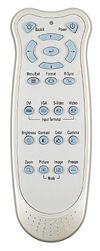Optoma H56 DLP front projector Page 2
In addition to supporting HDTV images in both Y-Pb-Pr and RGB formats, the H56 handles a slew of PC display standards, from VGA (640x480) to SXGA (1280x1024). I tested 25 different PC scan rates using an Extron VTG200 test generator, and the H56 was able to set 'em all up correctly with one touch of its Autosync button. You can fine-tune the pixel clock and phase, too, and there are horizontal and vertical image-position adjustments.
Unfortunately, you don't have access to horizontal and vertical position controls with DVI inputs, but you can tweak image blanking and gamma in DVI mode. In theory, a DVI signal should need no position adjustments—that information (and blanking and refresh info) is provided by the projector to the DVI driver. In practice, it didn't work with a 1280x720p DVI signal from my Samsung SIR-T165 set-top tuner; the resulting image on the H56 was shifted 50% to the left and could not be moved. This was not a problem with the component or RGB inputs. [Optoma says that this problem has been fixed with a firmware upgrade.—Ed]
Video Quality
The H56's comb filter provided average performance with component video sources, clipping out lots of detail in the 400-line Zone Plate patterns on the Video Essentials test DVD. There was plenty of color moiré evident on the moving plate, as well as in the 300- and 400-line grids, so use the S-video and component inputs whenever possible.
Component 480i was the sharpest of all interlaced input modes. Deinterlacing and motion compensation weren't quite as good as with my Panasonic RP56 progressive-scan DVD player, though. I easily spotted scan-line artifacts in VE's waving flag and bridge pan/zoom sequences that are all but eliminated by the RP56 with its Faroudja FLI2200 DCDi processor. The Optoma's Silicon Image deinterlacing circuit also had some problems picking up a rapid transition from film to video and back to film on VE with Auto mode selected, but did better with film material when that mode was selected exclusively.
 The "sweet spot" for image quality was found when I married the RP56 to the H56—the smooth, soft-grain appearance of the single DMD meshed nicely with scenes from Men In Black, Pearl Harbor, and Back to the Future. This is where the H56 performed at its best: displaying 480p DVDs and 720p HD material (which is ABC's HDTV format).
The "sweet spot" for image quality was found when I married the RP56 to the H56—the smooth, soft-grain appearance of the single DMD meshed nicely with scenes from Men In Black, Pearl Harbor, and Back to the Future. This is where the H56 performed at its best: displaying 480p DVDs and 720p HD material (which is ABC's HDTV format).
I loaded up a variety of 720p clips from the Super Bowl on D-VHS and had pretty much the same reaction as my guests. The widescreen resolution of 1024x576 pixels for HD and 1.85:1 DVDs wasn't a perfect match, but it didn't matter—the images we saw were very pleasing to the eye, and they lacked the screen-door effect common to LCD projectors.
After spending several hours with the H56's frustrating white-balance controls, I could see that the green of the football field would never match that represented by my Princeton AF3.0HD CRT monitor—but that's true of most business-based projectors, as well as a few higher-priced home-theater designs. The magenta shift in the H56's supposedly neutral "2" color-temperature setting was more noticeable in Back to the Future Part III, which has lots of warm reds and yellows, but it was not as noticeable in MIB. However, I did see some green shift in deep shadows with MIB after my final attempt at color calibration.
Source signals encoded at 1080i were not as crisp as I've seen them on widescreen LCD and DLP projectors. Considering that a 47% pixel decimation is required to resize 1080i video to fit the width of the H56's DMD, that may not be surprising. But there's another possible reason: the H56's HDTV frequency response.
Using chroma and luma multiburst patterns from an AccuPel HDG-2000 test-pattern generator, I could see detail up to 18.5MHz, but there was significant rolloff at 37.5MHz in both Y-Pb-Pr and RGB modes. Believe it or not, that's better than some higher-priced projectors I've tested recently!
Conclusions
The Optoma H56 is an enigma. The projector's black levels and contrast were excellent, showing what the new DDR DMDs are capable of. The H56 could put some sweet images on the screen when driven by a quality progressive-scan DVD player, and it shone with 720p content.
However, many of its features and performance benchmarks left me wanting more. For example, the H56 could use some extra bandwidth for high-definition signals. As revealed in the "Calibration and Performance" sidebar, the H56 needs help with its white-balance calibrations, and the green-shift problem with tri-level-sync 1080i is a major drawback.
All in all, the Optoma H56 seems a work in progress with lots of unrealized potential. If Optoma were to address the problems with 1080i Y-Pb-Pr color shift, restricted bandwidth, and the nearly impossible color-calibration sliders, then I'd be more enthusiastic about this projector. In its present form, the H56 is just another business projector that happens to show DVDs and HDTV better than many other business projectors.




























































